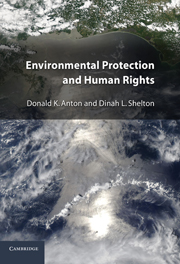Book contents
- Frontmatter
- Contents
- Acknowledgments
- Abbreviations
- Table of Cases
- 1 Law and the Environment
- 2 The Environment as a Human Rights Issue
- 3 An Introduction to Human Rights Origins and Theory
- 4 The International Protection of Human Rights
- 5 International Human Rights Institutions and Procedures
- 6 Procedural Human Rights and the Environment
- 7 Substantive Human Rights and the Environment
- 8 Indigenous Peoples, Rights, and the Environment
- 9 Humanitarian Crises: Armed Conflicts and Other Disasters
- 10 Environmental Rights and International Finance: The World Bank Example
- 11 Human Rights, the Environment, and Corporate Accountability
- Index
4 - The International Protection of Human Rights
Published online by Cambridge University Press: 05 June 2012
- Frontmatter
- Contents
- Acknowledgments
- Abbreviations
- Table of Cases
- 1 Law and the Environment
- 2 The Environment as a Human Rights Issue
- 3 An Introduction to Human Rights Origins and Theory
- 4 The International Protection of Human Rights
- 5 International Human Rights Institutions and Procedures
- 6 Procedural Human Rights and the Environment
- 7 Substantive Human Rights and the Environment
- 8 Indigenous Peoples, Rights, and the Environment
- 9 Humanitarian Crises: Armed Conflicts and Other Disasters
- 10 Environmental Rights and International Finance: The World Bank Example
- 11 Human Rights, the Environment, and Corporate Accountability
- Index
Summary
Introduction
To appreciate the role of human rights in the cause of environmental protection, it is essential that you understand the nature and evolution of human rights law. In this dynamic field, the relationship between environmental protection and human rights is still very much a work in progress. Studying the growth in the corpus of human rights norms and institutions will aid in developing a sense of if and when asserted environmental rights can be brought to bear on various situations.
This chapter starts with the opening of the modern era of human rights following World War II and takes you through the development of what is called the International Bill of Rights and other so-called core global treaties. It then presents an overview of regional systems that complement and supplement the U.N. efforts. The chapter then considers several important and unique features of human rights treaties and the implication those features have for environmental protection. As in Chapter 3, the readings in this chapter continue to highlight the essential features of human rights generally to prepare the way for more detailed consideration in subsequent chapters of how they relate to the environment.
After the trauma of World War II, states sought to create global and regional organizations that would help ensure that war would be avoided and human rights respected. The United Nations attempts to do both.
- Type
- Chapter
- Information
- Environmental Protection and Human Rights , pp. 224 - 280Publisher: Cambridge University PressPrint publication year: 2011



